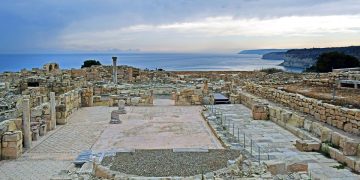The Timeless Beauty of Ancient Architecture: A Journey Through the Ages
Ancient architecture has always held a special allure for those who appreciate the beauty and craftsmanship of the past. From the towering pyramids of Egypt to the intricate temples of Angkor Wat, these ancient structures have stood the test of time, captivating visitors with their grandeur and mystery. In this article, we will take a journey through the ages to explore the enduring beauty of ancient architecture and the secrets it holds.
The Pyramids of Egypt: A Testament to Ancient Engineering
When we think of ancient architecture, one of the first images that comes to mind is the majestic pyramids of Egypt. Built over 4,500 years ago, these massive structures were constructed as tombs for the pharaohs of Egypt. The Great Pyramid of Giza, the largest of the three pyramids, is a marvel of engineering and precision. Its perfectly aligned sides and intricate interior chambers are a testament to the skill and ingenuity of the ancient Egyptians.
Despite the passage of millennia, the pyramids still stand as a symbol of Egypt’s rich history and cultural heritage. Visitors from around the world flock to see these ancient wonders, marveling at the sheer size and scale of the structures. The mystery of how the pyramids were built continues to captivate historians and archaeologists, adding to their allure and mystique.
The Parthenon: A Masterpiece of Classical Architecture
In ancient Greece, architecture reached new heights of beauty and sophistication with the construction of the Parthenon. Built in the 5th century BC, this temple dedicated to the goddess Athena is a masterpiece of classical architecture. Its elegant columns, intricate friezes, and sculptural decorations are a testament to the skill and artistry of the ancient Greeks.
The Parthenon has inspired architects and artists for centuries, its harmonious proportions and graceful design serving as a model for countless buildings around the world. Despite centuries of war, earthquakes, and vandalism, the Parthenon still stands as a symbol of Greece’s cultural and artistic achievements, drawing visitors from far and wide to marvel at its beauty.
The Colosseum: An Icon of Roman Ingenuity
In ancient Rome, the Colosseum stood as a testament to the power and grandeur of the Roman Empire. Built in the 1st century AD, this massive amphitheater could seat up to 80,000 spectators and was used for gladiatorial contests, animal hunts, and other public spectacles. Its innovative design, which included a system of ramps and corridors for easy access, set a new standard for large-scale entertainment venues.
Despite centuries of neglect and damage, the Colosseum still stands as an icon of Roman ingenuity and engineering. Visitors to Rome continue to be awed by its massive size and complex design, marveling at the skill and craftsmanship of the ancient builders. The Colosseum serves as a reminder of Rome’s cultural and architectural legacy, a testament to the enduring power of ancient architecture.
Angkor Wat: A Jewel of Khmer Architecture
In Cambodia, the ancient city of Angkor was once the capital of the Khmer Empire, a powerful civilization that ruled much of Southeast Asia from the 9th to the 15th centuries. At the heart of this city lies Angkor Wat, a massive temple complex dedicated to the Hindu god Vishnu. Built in the 12th century, Angkor Wat is a masterpiece of Khmer architecture, with its intricate carvings, towering spires, and expansive courtyards.
Despite centuries of neglect and abandonment, Angkor Wat still stands as a testament to the skill and artistry of the Khmer builders. Visitors to this UNESCO World Heritage site are captivated by its beauty and grandeur, marveling at the intricate details and sheer scale of the complex. Angkor Wat serves as a reminder of Cambodia’s rich cultural heritage and the enduring legacy of the Khmer Empire.
The Taj Mahal: A Symbol of Love and Beauty
In India, the Taj Mahal stands as a symbol of enduring love and beauty. Built in the 17th century by the Mughal emperor Shah Jahan in memory of his beloved wife, Mumtaz Mahal, this magnificent white marble mausoleum is a masterpiece of Mughal architecture. Its graceful domes, intricate carvings, and lush gardens make it one of the most beautiful buildings in the world.
Despite centuries of pollution and deterioration, the Taj Mahal still stands as a shimmering symbol of love and devotion. Visitors from around the world flock to see this UNESCO World Heritage site, marveling at its beauty and elegance. The Taj Mahal serves as a reminder of India’s rich cultural heritage and the enduring power of love.
Conclusion: The Enduring Beauty of Ancient Architecture
As we have seen, ancient architecture holds a timeless beauty that continues to captivate and inspire us today. From the towering pyramids of Egypt to the graceful temples of Angkor Wat, these ancient structures stand as a testament to the skill, creativity, and ingenuity of our ancestors. Despite centuries of neglect, war, and natural disasters, these buildings still stand as symbols of our shared human heritage, reminding us of the power and beauty of the past.
Visitors from around the world continue to flock to these ancient sites, eager to marvel at their beauty and mystery. The enduring allure of ancient architecture lies in its ability to transport us back in time, to a world where craftsmanship and artistry were valued above all else. As we journey through the ages, let us continue to appreciate and preserve these ancient treasures, ensuring that future generations can also experience the timeless beauty of ancient architecture.












